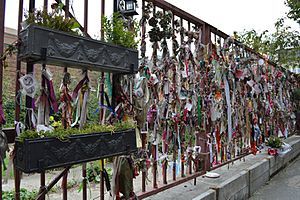Cross Bones facts for kids

Cross Bones gate, September 2014
|
|
| Lua error in Module:Location_map at line 420: attempt to index field 'wikibase' (a nil value). | |
| Details | |
|---|---|
| Established | Earliest mention 1598 |
| Closed | 1853 |
| Location |
Redcross Way, Southwark, south London, SE1
|
| Country | England |
| Owned by | Transport for London (as of 2014) |
| No. of graves | Up to 15,000 |
Cross Bones is an old burial ground in Southwark, south London. It is located on Redcross Way. People believe that as many as 15,000 people were buried here. The burial ground was officially closed in 1853.
Cross Bones was likely started as an unconsecrated graveyard. This means it was not blessed by a church. The area was outside the main City of London. Because of this, it became known for its many theatres. By 1769, it was used as a cemetery for poor people. These people were from the local St. Saviour's parish.
Contents
Why Cross Bones Closed
The Cross Bones graveyard was closed in 1853. It was closed because it was "completely overcharged with dead." This means too many people had been buried there. There was no more space left.
What Happened to the Land?
A local writer named John Constable wrote about Cross Bones. He said the land was sold in 1883. It was meant to be used for new buildings. However, the sale was cancelled the next year. This happened because of a law called the Disused Burial Grounds Act 1884. This law stopped building on old burial sites.
Local people did not want buildings on the site. They fought against new construction. Later, the remains of the buried people were moved. They went to parish facilities in Brookwood, Surrey. After that, warehouses and other business buildings were put on the land.
Discoveries at Cross Bones
Between 1991 and 1998, archaeologists dug up the land. This happened because the London Underground was building the Jubilee line. The Museum of London Archaeology Service led these digs.
What Archaeologists Found
Southwark Council reported on what the archaeologists found. They discovered a very crowded graveyard. Many people were buried close together. Scientists tested the bones found there. They learned that the buried people had suffered from several diseases. These included smallpox and tuberculosis. They also had Paget's disease and osteoarthritis. Many also showed signs of vitamin D deficiency.
In 1992, one dig found 148 graves. These graves were from between 1800 and 1853.
Images for kids





